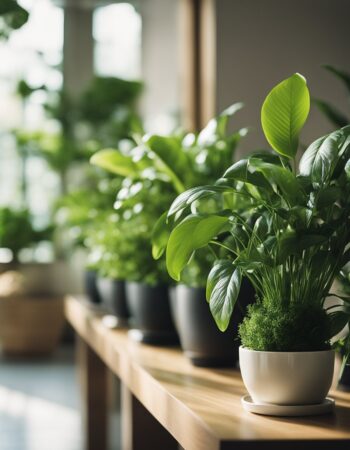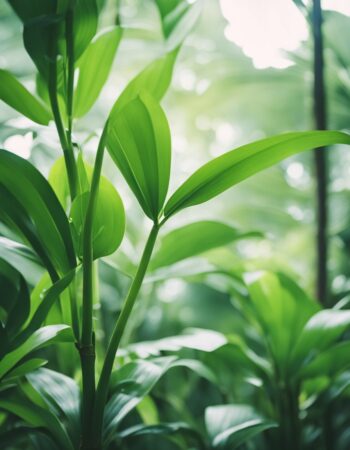Indoor air pollution is a growing concern for many people, especially those living in urban areas. To combat this issue, many are turning to plants as a natural and effective way to purify the air in their homes and offices. In this article, we will explore the five best plants for cleaning indoor air.
Plants have been shown to remove harmful toxins from the air, such as benzene, formaldehyde, and trichloroethylene. These toxins are commonly found in household products such as cleaning supplies, furniture, and carpets. By adding plants to your indoor environment, you can reduce your exposure to these harmful chemicals and improve your overall health.
The five plants we will discuss in this article are known for their air-purifying qualities and are easy to care for. Whether you have a green thumb or are new to gardening, these plants are a great addition to any indoor space. So, let’s dive in and discover the best plants for cleaning indoor air.
Understanding Indoor Air Pollution
Indoor air pollution refers to the presence of harmful pollutants, toxins, and chemicals in the air inside buildings. These pollutants can come from a variety of sources, including building materials, cleaning products, and even outdoor air that enters the building.
Some of the most common indoor air pollutants include volatile organic compounds (VOCs), carbon monoxide, and carbon dioxide. VOCs are emitted by a wide range of products, including paints, adhesives, and cleaning supplies. Carbon monoxide is produced by gas stoves, fireplaces, and other fuel-burning appliances, while carbon dioxide is a byproduct of human respiration.
Indoor air pollution can have a range of negative health effects, including respiratory problems, headaches, and fatigue. Children, the elderly, and people with pre-existing health conditions may be particularly vulnerable to the harmful effects of indoor air pollution.
To reduce indoor air pollution, it is important to identify and eliminate sources of harmful toxins and chemicals. This can involve using natural cleaning products, improving ventilation, and choosing building materials that are low in VOCs. Regular maintenance of fuel-burning appliances is also important to prevent the buildup of carbon monoxide.
In summary, understanding indoor air quality and taking steps to reduce it can have a significant positive impact on the health and well-being of building occupants.
The Science Behind Air-Purifying Plants
Air quality is a major concern in today’s world, especially in urban areas. Poor air quality can lead to a variety of health problems, including respiratory issues, allergies, and even cancer. One solution to this problem is to use air-purifying plants.
NASA conducted a study in the late 1980s to determine the effectiveness of various plants in purifying indoor air. The study found that certain plants were highly effective at removing pollutants such as formaldehyde, benzene, and trichloroethylene from the air.
Air-purifying plants work by absorbing pollutants through their leaves and roots. They then convert these pollutants into harmless substances or use them as nutrients. In addition, plants release oxygen into the air, improving the overall air quality.
Some of the best air-purifying plants include the spider plant, snake plant, peace lily, Boston fern, and aloe vera. These plants are not only effective at purifying the air, but they are also easy to care for and can thrive in a variety of environments.
Overall, air-purifying plants are a natural and effective way to improve indoor air quality. By incorporating these plants into your home or office, you can breathe easier and enjoy a healthier environment.
Top 5 Plants for Cleaning Indoor Air
Indoor air pollution is a growing concern, and one of the easiest ways to improve the air quality in your home or office is by adding some plants. Here are the top 5 plants that are known to be effective in cleaning indoor air:
-
Spider Plant – Spider plants are easy to care for and are known for their ability to remove formaldehyde, xylene, and toluene from the air.
-
Snake Plant – Snake plants are also low maintenance and can efficiently remove pollutants such as benzene, formaldehyde, trichloroethylene, and xylene.
-
Peace Lily – Peace lilies are not only beautiful but also great at removing toxins like benzene, formaldehyde, and trichloroethylene.
-
Bamboo Palm – Bamboo palms are excellent at removing formaldehyde, benzene, and trichloroethylene from the air.
-
Dracaena – Dracaenas come in various sizes and shapes and are effective at removing pollutants like benzene, formaldehyde, trichloroethylene, and xylene.
Adding any of these plants to your indoor space can help improve air quality and promote a healthier environment.
Specific Toxins and The Plants That Absorb Them
Indoor air can be contaminated with various toxins that can cause harm to human health. Some of the most common toxins found in indoor air include formaldehyde, benzene, trichloroethylene, xylene, ammonia, toluene, mold, and mold spores. Fortunately, there are several plants that can absorb these toxins and purify the air.
Formaldehyde
Formaldehyde is a common indoor air pollutant that can cause irritation of the eyes, nose, and throat. It is found in many household items such as furniture, carpets, and cleaning products. Plants that are effective at absorbing formaldehyde include:
- Snake Plant
- Spider Plant
- Golden Pothos
- Peace Lily
- Chrysanthemum
Benzene
Benzene is a toxic chemical that is commonly found in cigarette smoke, gasoline, and other industrial products. Exposure to benzene can cause dizziness, headaches, and even cancer. Plants that are effective at absorbing benzene include:
- English Ivy
- Peace Lily
- Snake Plant
- Bamboo Palm
- Rubber Plant
Trichloroethylene
Trichloroethylene is a toxic chemical that is commonly found in solvents and cleaning products. Exposure to trichloroethylene can cause headaches, dizziness, and even liver damage. Plants that are effective at absorbing trichloroethylene include:
- Peace Lily
- Snake Plant
- Spider Plant
- Bamboo Palm
- Gerbera Daisy
Xylene
Xylene is a toxic chemical that is commonly found in paints, varnishes, and adhesives. Exposure to xylene can cause headaches, dizziness, and even kidney damage. Plants that are effective at absorbing xylene include:
- Spider Plant
- Peace Lily
- Rubber Plant
- Bamboo Palm
- Janet Craig
Ammonia and Toluene
Ammonia and toluene are toxic chemicals that are commonly found in cleaning products. Exposure to these chemicals can cause respiratory problems, headaches, and even kidney damage. Plants that are effective at absorbing ammonia and toluene include:
- Spider Plant
- Peace Lily
- Boston Fern
- Bamboo Palm
- Janet Craig
Mold and Mold Spores
Mold and mold spores can cause respiratory problems and allergies. Plants that are effective at absorbing mold and mold spores include:
- Spider Plant
- Boston Fern
- Peace Lily
- English Ivy
- Bamboo Palm
In conclusion, incorporating these plants into your indoor environment can help purify the air and improve your overall health.
Additional Benefits of Indoor Plants
Indoor plants not only add an aesthetic appeal to your home or office, but they also provide several additional benefits. Here are some of them:
Health Benefits
Indoor plants are known to improve air quality by removing harmful toxins and pollutants. They absorb carbon dioxide and release oxygen, which can help reduce the risk of respiratory problems. Studies have shown that having plants in your indoor space can also lower the risk of illnesses such as colds and flu.
Humidity Control
Indoor plants can help regulate humidity levels in your home or office. They release moisture into the air through a process called transpiration, which can help prevent dry skin, sore throats, and respiratory problems.
Stress Reduction
Indoor plants have a calming effect on the mind and body. They can help reduce stress levels and promote relaxation. Studies have shown that simply looking at plants can have a positive effect on mood and stress levels.
Improved Mood and Concentration
Indoor plants can also improve mood and concentration levels. They provide a sense of well-being and can help increase productivity and creativity. Studies have shown that having plants in the workplace can increase job satisfaction and reduce absenteeism.
Greenery
Indoor plants provide a natural element to your indoor space. They can help create a calming and peaceful atmosphere, and can also add color and texture to your decor.
In summary, having indoor plants can provide numerous benefits beyond just their visual appeal. They can improve air quality, regulate humidity levels, reduce stress, improve mood and concentration, and add a natural element to your indoor space.
Considerations When Choosing Air-Purifying Plants
When selecting air-purifying plants, there are several factors to consider. First and foremost, it is essential to choose plants that are safe for pets, as some plants can be toxic to dogs and cats. Additionally, certain plants may be better suited for specific rooms in the home, such as the bedroom, where air quality is particularly important.
Plants that are effective at removing smoke and other pollutants from the air may also be a priority for some individuals. Moisture levels in the home can also impact plant health, so it is important to choose plants that can thrive in the environment they will be placed in.
Consideration should also be given to the amount of bright light a plant requires, as well as the potential for root rot if overwatered. Price and availability may also be factors to consider, especially if looking for plants in stock at local nurseries or online retailers.
Overall, it is important to do research and select plants that are suitable for the specific needs and environment of the home. It is also important to note that while plants can improve indoor air quality, they should not be relied upon as the only means of purifying the air.
Note: This article may contain affiliate links.
Frequently Asked Questions
What are the top 5 air purifying plants recommended by NASA?
NASA’s Clean Air Study recommends the following top 5 air purifying plants: Areca Palm, Lady Palm, Bamboo Palm, Rubber Plant, and Dracaena.
What are some indoor air purifying plants that thrive in low light?
Some indoor air purifying plants that thrive in low light include Snake Plant, Peace Lily, ZZ Plant, and Devil’s Ivy.
What are some air purifying plants suitable for a bathroom?
Air purifying plants suitable for a bathroom include Spider Plant, Boston Fern, Aloe Vera, and English Ivy.
Which indoor plants are the best at reducing dust in the house?
Indoor plants that are best at reducing dust in the house include Spider Plant, Rubber Plant, Peace Lily, and Boston Fern.
What is the new plant that is known for its air cleaning abilities?
The new plant that is known for its air cleaning abilities is the Pothos plant. It is an easy-to-care-for plant that can help remove toxins such as formaldehyde and benzene from the air.
Which plants are natural air purifiers and how do they work?
Plants such as Snake Plant, Spider Plant, and Peace Lily are natural air purifiers. They work by absorbing harmful chemicals and pollutants from the air through their leaves and roots, and converting them into harmless substances. Additionally, they release oxygen into the air, making it cleaner and fresher to breathe.


